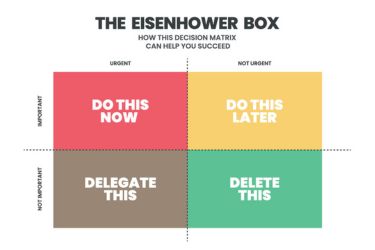Many of us have heard of Stephen R. Covey’s famous book, The 7 Habits of Highly Effective People, but the real challenge is putting those ideas into practice. Habit 1, "Be Proactive," teaches us to take responsibility for our own lives and focus on what we can control, rather than blaming circumstances or other people. This mindset shift is powerful and can change how we react to daily situations.

When we choose to be proactive, we work within our Circle of Influence, acting based on our values instead of our moods, environment or other people’s behaviour. Proactive language helps us lead by example and encourages us to take small steps forward, even in difficult situations. By practising this habit, we become more effective and confident in our decisions, setting the tone for all the other habits.
Key Takeaways
- "Be Proactive" means taking responsibility and acting on what we can control.
- Focusing on our Circle of Influence helps us build stronger habits.
- Using proactive language shapes our mindset and behaviour.
Understanding 'Be Proactive' in The 7 Habits Framework
Being proactive is the cornerstone of Stephen R. Covey's approach. This principle explains how our choices shape our lives and why taking responsibility is key to personal and professional growth.
Defining Proactivity Versus Reactivity
Proactive people take responsibility for their actions and focus on what they can control. They do not blame circumstances or others for their situation. Instead, they use their values to guide decisions, regardless of external events.
Reactive people let outside forces, conditions, or moods determine how they feel and act. When faced with challenges, they may complain, blame, or wait for someone else to act. We see the difference in how each group responds to stress—proactive people pause and choose a positive response, while reactive people often react impulsively.
A key idea from The 7 Habits of Highly Effective People is the "Circle of Influence". Proactive individuals focus their energy on issues they can do something about, expanding their influence over time. Reactive individuals spend most of their energy worrying about things they cannot control, which shrinks their influence.
| Proactive People | Reactive People |
|---|---|
| Focus on what they can control | Focus on what they cannot control |
| Take responsibility for actions | Blame others or circumstances |
| Respond based on values | React based on feelings or environments |
The Role of Habit 1 in Personal Development
Habit 1: Be Proactive is the starting point for personal change. When we are proactive, we move from being victims of our environment to becoming creators of our outcomes. This habit builds self-awareness, as we start noticing the space between stimulus and response.
Developing this habit means understanding that we have power over our choices. Covey notes that while we cannot always control what happens, we can control how we respond. By practising self-reflection, we make better decisions based on long-term goals, not just short-term feelings.
This habit also encourages us to use language that reflects our responsibility. Saying "I choose" or "I will" helps reinforce our sense of control. As we live more proactively, we build confidence and the ability to set and achieve personal and professional goals.
Why 'Be Proactive' Is the First Habit
Covey places Be Proactive first because it acts as the foundation for all the other 7 habits. Our ability to choose our response in any situation is essential before we can develop habits like beginning with the end in mind or putting first things first.
If we start by blaming others or feeling powerless, it is difficult to build trust, set effective goals, or manage time well. Habit 1 lays the groundwork for growth because it empowers us to act rather than wait.
In the 7 Habits framework, "be proactive" is crucial since it shifts our mindset from being at the mercy of events to taking control of our paths. Without this habit, progress in the other areas is limited. Covey argues that all meaningful change starts from this point of personal responsibility.
Principles of Personal Responsibility and Choice
Becoming proactive is about more than positive thinking; it requires us to understand our ability to make conscious decisions, take ownership of our lives, and let our values guide our actions. This habit is built on the idea that we are not simply shaped by circumstances, but by the choices we make every day.
Freedom to Choose Your Response
We all face situations that test us. Events or people may push us towards certain reactions, but we hold the ability to choose our response.
Stephen Covey teaches that between a stimulus and our reaction, there exists a space where we decide how to act. This space is where our true freedom lies, giving us the power to think before we react. Our response is, therefore, not automatic but a conscious decision.
Taking responsibility for this choice means admitting that what we say and do is not controlled by others or by circumstances. Rather, we can pause, reflect, and select a response that aligns with our intentions. This knowledge empowers us, even in difficult situations.
Values as the Foundation of Behaviour
Our behaviour should come from our values, not simply from feelings or outside pressures. When we know what matters to us, we are less likely to react impulsively or blame others.
To live by our values, we need to be clear about what those values are. Making a list or table of our core values can help:
| Value | Example Behaviour |
|---|---|
| Honesty | Telling the truth |
| Respect | Listening before responding |
| Responsibility | Admitting mistakes |
When we choose actions based on these values, our decisions become consistent and trustworthy. Our values give us direction and help us act, rather than react.
Attitude and Performance
Proactive people understand that their attitude influences their performance. We cannot always control what happens to us, but we can control our mindset and how we approach problems.
By choosing a positive, responsible attitude, we improve our chances of success. For example, if we face a setback at work, we decide whether to see it as a defeat or a lesson to learn from. This small shift in attitude directly affects our performance and growth.
Managing our attitude helps set the conditions for personal and professional growth. It allows us to keep moving forward, even when faced with setbacks or challenges.
Circles of Influence and Concern
Understanding the Circle of Influence and Circle of Concern helps us see where we should put our energy for the best outcomes. Focusing on what we can control leads to better habits and less stress.
Focusing on What You Can Control
The Circle of Concern contains everything we care or worry about, such as world events, the opinions of others, or things far outside our reach. In contrast, the Circle of Influence includes the things we actually have power over, like our choices, habits, and how we spend our time.
Proactive people put their attention on their Circle of Influence. For example, instead of worrying about a company-wide policy, we can focus on improving our own performance at work. This practical approach protects our energy. By concentrating on things we can change, we become more effective and less anxious about the things we cannot affect.
To help sort these areas, we can use a simple table:
| Circle | Examples |
|---|---|
| Circle of Concern | Economy, global politics, weather, gossip |
| Circle of Influence | Our responses, learning, health, behaviour |
Expanding Your Circle of Influence
We grow our Circle of Influence by spending time on what matters and taking small, consistent actions. When we act responsibly, keep promises, and look after ourselves and others, we show we can be trusted. This is how proactive people expand what they can influence over time.
For instance, regular effort at work can lead to more responsibility. Helping others or improving our skills can give us more options in the future. As our Circle of Influence grows, we experience more control in different parts of our lives.
It's important to remember that our influence is not fixed. The more energy we give to positive, actionable areas, the bigger our influence becomes. This helps build confidence and resilience.
Reducing Unproductive Concern
Reactive people often spend too much time in their Circle of Concern, worrying about topics they cannot control. This can lead to frustration, stress, and feelings of helplessness.
We reduce unproductive concern by shifting our attention to our Circle of Influence. This doesn’t mean we ignore problems, but we focus on what we can actually do next. For example, instead of worrying about traffic, we can plan to leave earlier or find another route.
Another helpful tip is to limit time spent discussing or thinking about issues we cannot change. By doing so, we lower our stress and keep our minds on things that move us forward. This strategy leads to a more proactive and positive outlook.
Language and Mindset: Proactive vs Reactive
Our words shape our thoughts and guide our actions. The way we speak—both to ourselves and others—reflects whether we actively handle challenges or let circumstances control us.
Proactive Language and Its Impact
Proactive language puts us in control of our own lives. We use phrases that show responsibility and conscious choice, like “I can choose,” “Let’s find a solution,” or “I will.”
This way of speaking shows we believe in our power to respond, rather than being victims of our environment. By using proactive language, we stay focused on our goals and see possibilities, not just obstacles.
A simple change in words often leads to a shift in mindset. It builds confidence and increases our willingness to take action. The words we choose can either open doors for us or close them before we try.
Recognising Reactive Language
Reactive language signals that we feel powerless or controlled by outside forces. Common phrases include “I have to,” “There’s nothing I can do,” or “That’s just the way I am.”
Such statements suggest that we see ourselves as victims of circumstance, not as people who can change and improve things. This language often leads to a negative mindset, where blame and excuses replace action.
We should pay attention to the language we use every day. Spotting reactive phrases helps us realise when we are slipping into unhelpful patterns, so we can make a conscious choice to change.
Shifting from Reactivity to Proactivity
Moving from reactive to proactive thinking starts with awareness. We need to catch ourselves when using reactive language and swap those words for proactive, choice-based ones.
A useful tip is to keep a table like this handy:
| Reactive Statement | Proactive Alternative |
|---|---|
| “I can’t do anything.” | “I can try something new.” |
| “He makes me angry.” | “I control my response.” |
| “I have to do this.” | “I choose to do this.” |
Practice is key. Each time we spot ourselves using a reactive phrase, we can pause and reframe it. Over time, this strengthens our sense of control and helps us build more positive, effective habits. Each conscious choice leads us closer to being truly proactive.
Taking Initiative and Leading by Example
Being proactive means we do not wait for directions or let circumstances control us. By acting with purpose and openness, we set standards for ourselves and others, which encourages progress and trust.
Daily Practices for Being Proactive
To practise proactivity each day, we start by recognising what is within our control. Instead of blaming situations, we choose our responses. Keeping a proactive mindset lets us focus energy on actions rather than complaints.
Helpful strategies include:
- Setting clear priorities each morning
- Breaking tasks into smaller steps
- Using a planner or digital tool to track progress
- Reflecting on daily habits and adjusting where needed
We also benefit from regular self-checks. For example, asking, “What can I do right now to move forward?” keeps us engaged. This habit builds consistency, turning initiative into routine.
Influencing Others through Proactivity
When we show initiative, we set a visible standard for our teams and colleagues. Our behaviour often influences the atmosphere at work or at home. By taking the first step in finding solutions, we encourage others to do the same.
Effective leaders use simple actions, like volunteering for difficult tasks or helping when issues arise. Sharing our thought process openly, such as stating, “I’ll take the lead on this because it’s important,” models proactive thinking. This fosters a culture of support and action.
We also inspire innovative solutions when people see us take charge, especially in uncertain situations. Encouraging questions and welcoming feedback helps us create more engaged and motivated groups.
Building High-Trust Relationships
Trust grows when we consistently act on our words and take responsibility. By being proactive, we become reliable partners, team members, or friends. People know they can count on us to deliver and speak up with honesty.
Key elements include:
- Following through on promises
- Responding quickly to challenges
- Being transparent about decisions
Initiative signals dependability, which is at the heart of strong, high-trust relationships. When others notice our reliability, they become more willing to collaborate and share ideas. Over time, these actions lead to deeper connections and lasting mutual respect.
Integrating 'Be Proactive' into Everyday Life
We can apply Habit 1: Be Proactive from the 7 Habits of Highly Effective People through clear actions and self-assessment. Understanding our choices and tracking our progress makes being proactive a consistent part of daily life.
Practical Strategies for Sustainable Change
To embed being proactive into our routines, we start by recognising we are responsible for our actions and reactions. When a challenge occurs, we ask ourselves what we can control instead of blaming outside forces. This small mental shift helps us focus on solutions.
We can use a table or list to keep track of tasks we take initiative on, such as:
| Situation | Reactive Response | Proactive Response |
|---|---|---|
| Missed a deadline | Blame others for delay | Accept it, plan to improve |
| Conflict at work | Argue or avoid | Address it calmly |
| Change in schedule | Stress or complain | Adapt and find alternatives |
Setting personal goals, like responding calmly when upset or looking for solutions, also supports proactive habits. We should review these goals weekly and adjust them as needed.
Journaling can help us spot patterns in our thoughts and choices. By writing down our triggers and our responses, we can identify when we act proactively or reactively.
Measuring Personal Growth and Results
Measuring progress is important to make sure we are truly living Habit 1: Be Proactive. We can rate how often we act with intention instead of by impulse, using a simple self-check at the end of each day or week.
Ask ourselves:
- Did we respond thoughtfully to challenges?
- Did we focus on what we could change rather than complain?
- Did we avoid blaming external factors?
We can also seek feedback from trusted friends or colleagues, asking how we handle tough situations. If we notice a growth in patience or problem-solving, it is a sign we are improving.
Tracking our progress over time, even through brief check-ins or a habit tracker app, helps us see real changes. This makes the concept from the 7 Habits come alive in our everyday experiences.
Frequently Asked Questions
We explore what being proactive means based on Stephen Covey’s ideas, how we can use this habit in our daily lives, and how it shows up at work. We also offer activity suggestions, highlight the link between being proactive and personal effectiveness, and distinguish it from being reactive.
What does it mean to 'Be Proactive' according to Stephen Covey?
Being proactive means we take responsibility for our actions and choices. According to Covey, we respond to situations using our values, not just by reacting to outside events or pressures. We focus on what we can control and act intentionally, instead of waiting for things to happen to us.
How can one practice being proactive in daily life?
We can practise being proactive by pausing before we respond, especially in difficult moments. This gives us time to choose our actions. We can also plan our tasks ahead, anticipate problems, and decide how we will handle them rather than leaving them to chance.
What are some examples of proactive behaviour in a professional setting?
At work, we might show proactive behaviour by suggesting improvements to a process before issues arise. We could also ask for feedback regularly to identify areas to develop. Taking the lead on projects or setting clear goals for the team are also good examples.
Can you suggest activities that encourage proactive habits?
We can keep a daily journal to reflect on our choices and responses to situations. Setting small daily goals and reviewing our progress at the end of the day helps build proactive thinking. Role-playing tough scenarios in a safe setting lets us practise choosing our responses in advance.
How does being proactive relate to the overall effectiveness of an individual?
When we are proactive, we manage our time and energy more effectively. This allows us to handle problems before they grow and reduces stress. Taking initiative also helps us achieve our goals sooner and build better working relationships.
What are the differences between being proactive and reactive?
Proactive people act on their values and take responsibility for what they can control. Reactive people often let outside events or people dictate their actions. While proactive behaviour is about taking charge, being reactive means waiting to respond after something has already happened.

















